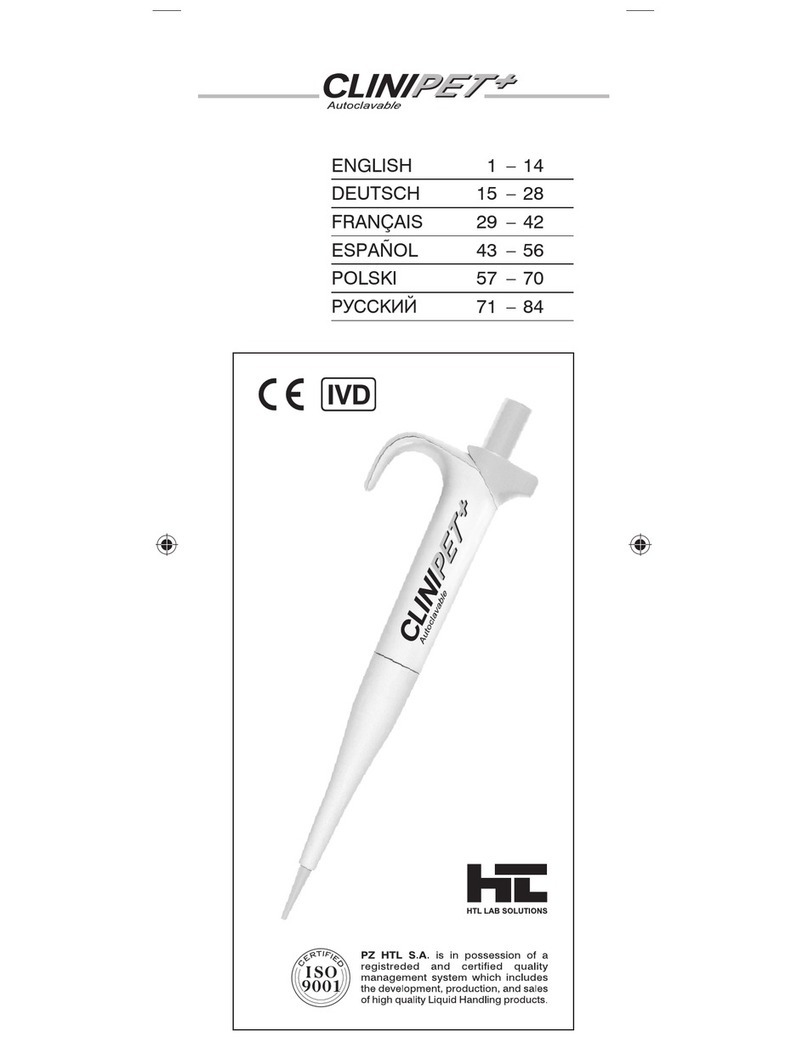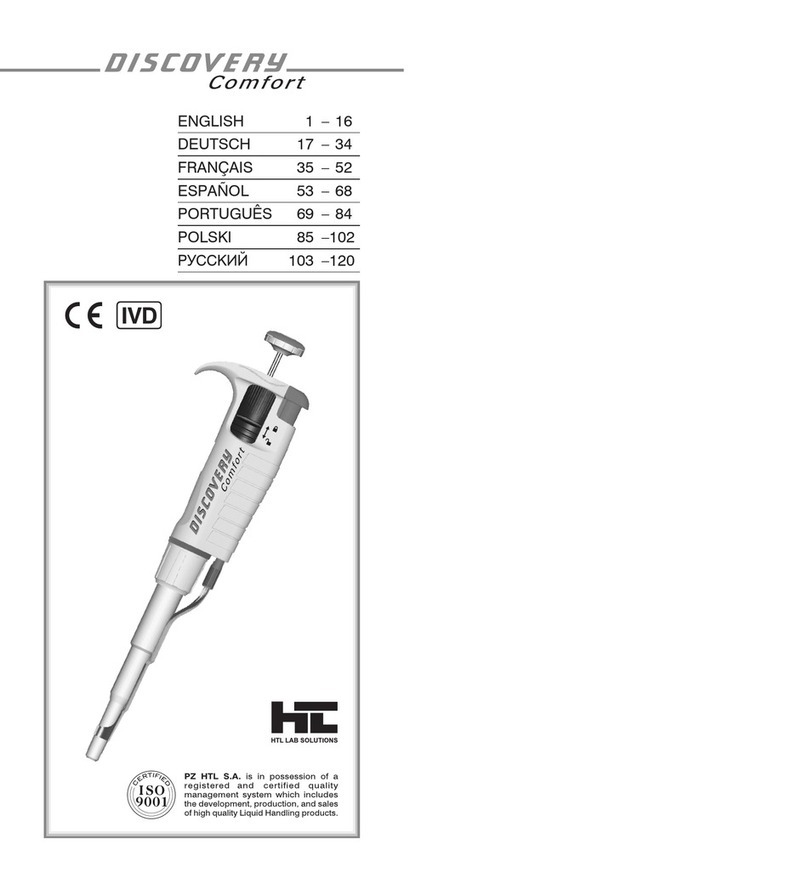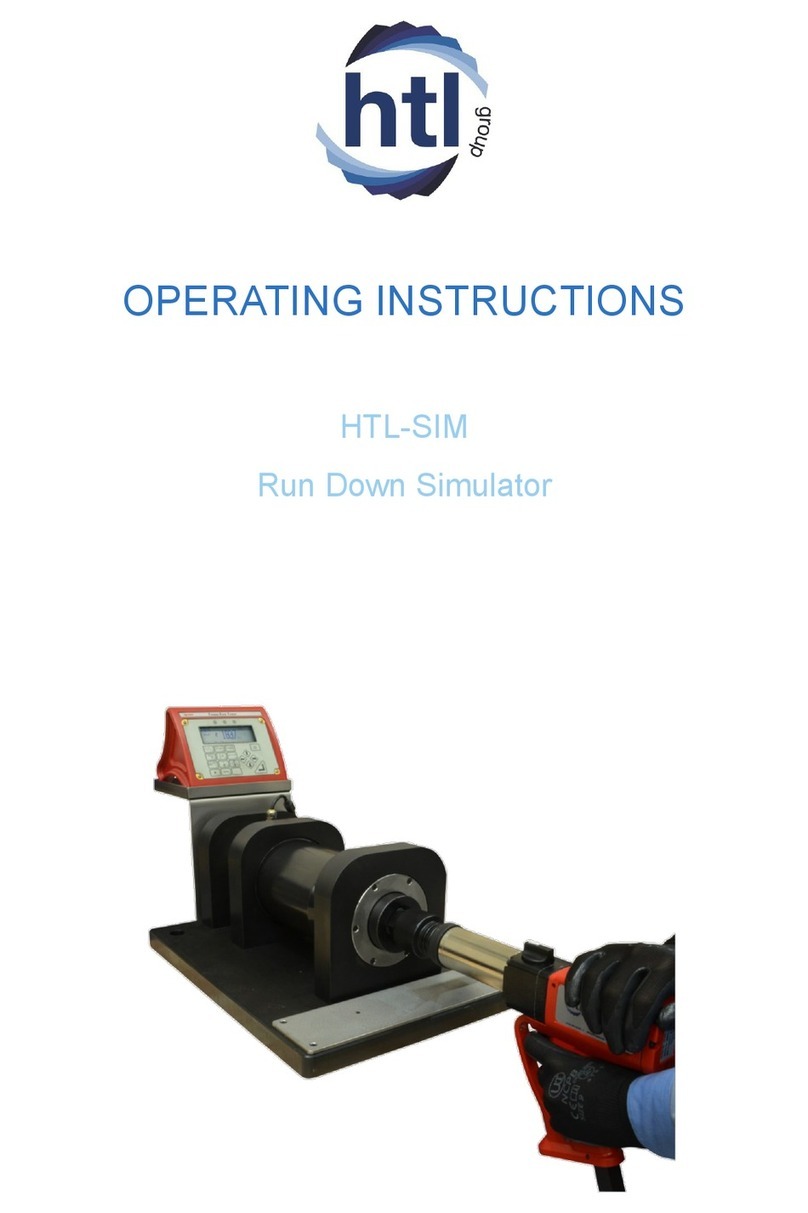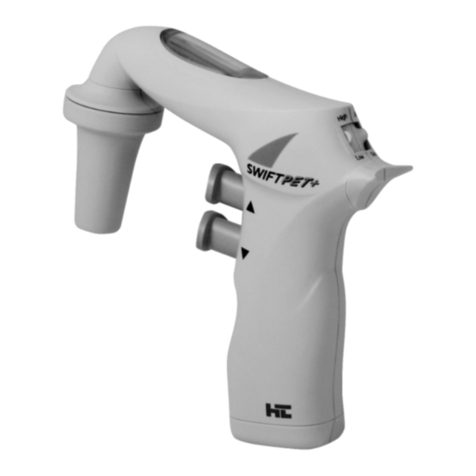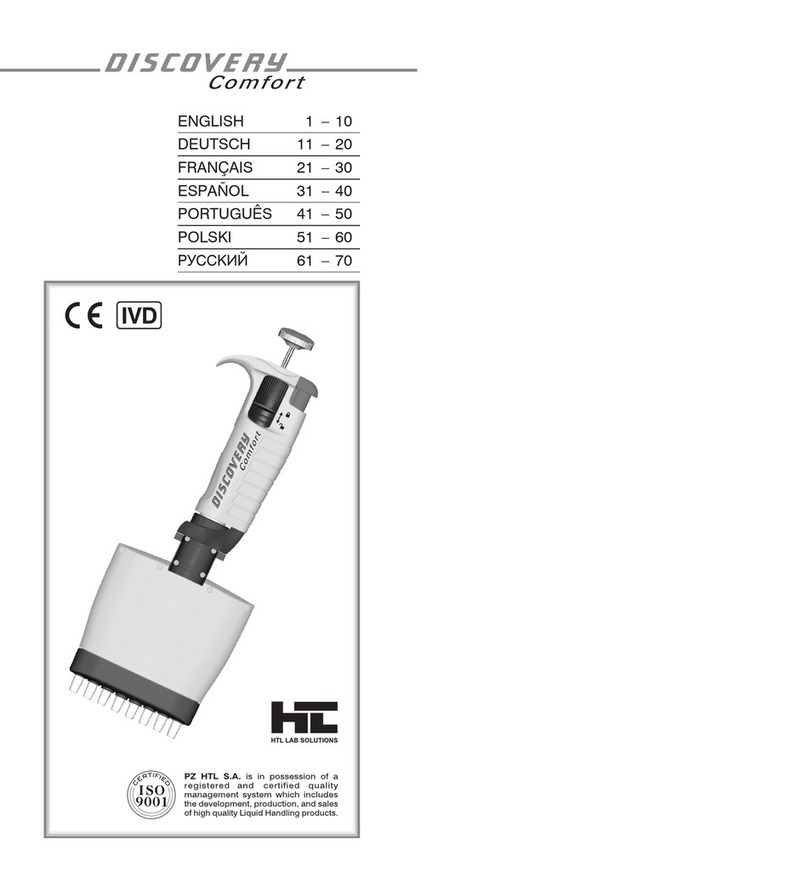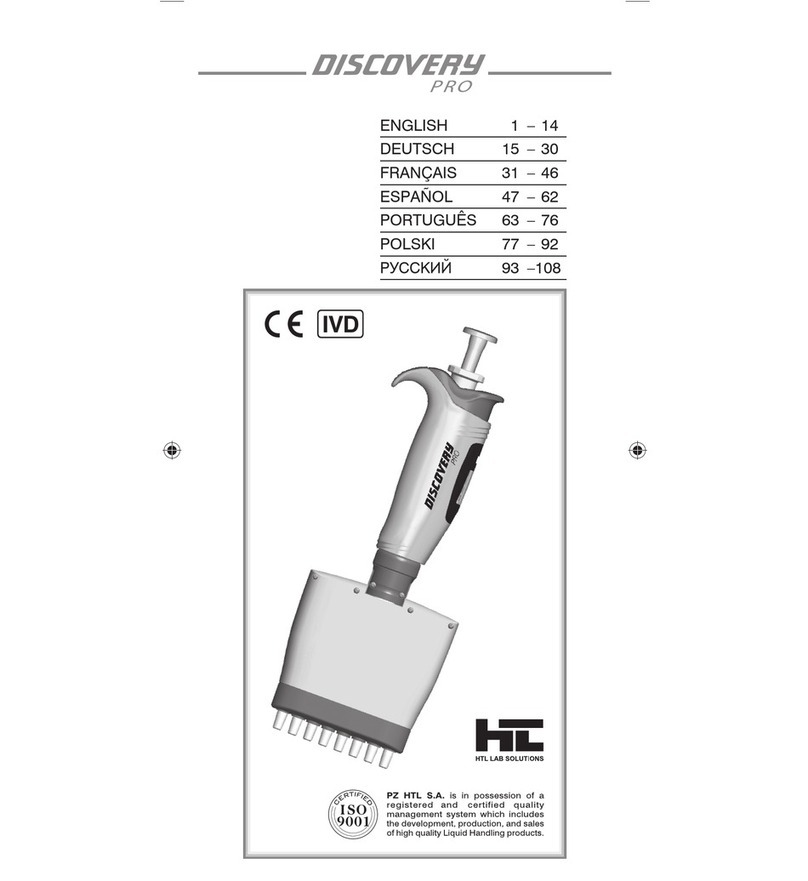11
3 - EINSCHRÄNKUNGEN FÜR DEN EINSATZ
• Verwenden Sie die Pipettierhilfe SWIFTPET nicht zum Abmessen von Substanzen, deren
Dämpfe die folgenden Materialien zerstören: PP, SI, ABS, EPDM, POM.
• Verwenden Sie die Pipettierhilfe nicht in einer explosionsgefährdenden Atmosphäre.
• Pipettieren Sie keine leicht entzündbaren Flüssigkeiten - insbesondere Substanzen mit
einer Entflammungstemperatur unter 0 °C (Äther, Azeton).
• Pipettieren Sie keine Säuren mit einer Konzentration von mehr als 1 Mol
• Pipettieren Sie keine Lösungen mit Temperaturen von über 50 °C
• Die Pipettierhilfe kann bei einer Temperatur von +10 °C bis +35 °C eingesetzt werden.
4 - INBETRIEBNAHME
Stellen Sie vor Inbetriebnahme sicher, dass der Geräte-Akku geladen ist. Hierzu die Entnah-
me-Taste (Abb. 1A) drücken und prüfen, ob die LOWBAT-Anzeige aufleuchtet (Abb. 1E).
Die Pipettierhilfe ist betriebsbereit, wenn dies nicht der Fall ist.
Beim Aufleuchten der LOWBAT-Anzeige die Pipettierhilfe aufladen (Empfehlung: erst aufladen,
dann weiterarbeiten) oder das Ladegerät anschließen und während des Aufladevorgangs
arbeiten. Die Pipettierhilfe SWIFTPET darf nur mit dem Original-Ladegerät aufgeladen werden.
Die Netzspannung muss mit der Kennzeichnung auf dem Ladegerät übereinstimmen.
Details zum Aufladen siehe Punkt 8 der Betriebsanleitung.
5 - ENTNAHME UND ABGABE VON FLÜSSIGKEIT
Befestigung der Pipette.
Bevor Sie die Pipette befestigen, ist sicherzustellen, dass sie nicht beschädigt ist und
keine Absplitterungen und scharfen Kanten am Halterteil hat. Prüfen Sie, ob das
Halterteil trocken ist.
Halten Sie die Pipette so weit oben wie möglich. Führen Sie die Pipette vorsichtig bis zum
Anschlag in den Halter der Pipettierhilfe. (Abb. 2A). Vermeiden Sie übermäßigen
Kraftaufwand, da die dünnen Pipetten leicht brechen und man sich schnell verletzen kann.
Die gut im Halter befestigte und abgedichtete Pipette darf sich nicht seitlich verschieben.
Halten Sie nach dem Befestigen der Pipette das Gerät so, dass sich die Pipette in
Senkrechtstellung befindet. Sie können die Pipettierhilfe mit der befestigten Pipette able-
gen, wenn sich keine Flüssigkeit in der Pipette befindet. Es empfiehlt sich, das Gerät nach
dem Abschluss der Arbeiten für längere Zeit, z.B. nachts oder übers Wochenende, nicht mit
montierter Pipette abzulegen.
Legen Sie die Pipettierhilfe nie ab, wenn sich Flüssigkeit in der Pipette befindet.
Füllen der Pipette
Schalten Sie die Geschwindigkeit mit dem Schalter HIGH/LOW (Abb. 1C) ein:
• Stellung HIGH - Schnellentnahme bei Volumen ab 5 ml
• Stellung LOW - Langsamentnahme bei Volumen bis 5 ml
SSWWIIFFTTPPEETT
Halten Sie die Pipettierhilfe so, dass sich die Pipette in Senkrechtstellung befindet. Tauchen
Sie die Pipettenspitze in die zu entnehmende Flüssigkeit. (Abb. 2B) Drücken Sie die
Entnahmetaste leicht. Die Ansauggeschwindigkeit hängt davon ab, wie weit Sie die
Entnahmetaste drücken, d.h. je weiter gedrückt wird, desto schneller wird Flüssigkeit in die
Pipette gefüllt.
Es ist zu empfehlen, etwas mehr Flüssigkeit zu entnehmen, als zur Abmessung vorgesehen
wird (der Meniskus über der Marke des geforderten Volumens). Reduzieren Sie die Entnah-
megeschwindigkeit in der Endphase der Entnahme damit die Pipette nicht überfüllt wird.
Einstellung des Volumens
Nach dem Füllen der Pipette trocknen Sie die Pipettenspitze mit einem saugfähigen Papier,
um Reste der Lösung an der Außenfläche der Pipette zu beseitigen. Das geforderte
Volumen stellen Sie ein, indem Sie überschüssige Flüssigkeit aus der Pipette entfernen.
Dazu drücken Sie vorsichtig die Ausgabetaste (Abb. 2C), bis der Meniskus der Flüssigkeit
genau mit der geforderten Volumenmarke auf der Pipette übereinstimmt.
Entleeren der Pipette
Halten Sie das Gefäß schräg und legen Sie die Pipettenspitze an die Gefäßwand an.
Drücken Sie vorsichtig die Ausgabetaste. (Abb. 2C). Die Abgabegeschwindigkeit hängt
davon ab, wie weit die Ausgabetaste gedrückt wird, d.h. je weiter gedrückt wird, desto
schneller tritt Flüssigkeit aus.
Die Pipettierhilfe SWIFTPET hat zwei Ausgabe-Betriebsarten. Die Ausgabe-Betriebsart
stellen Sie mit dem Schalter GRAV/BLOW ein (Abb. 1D).
• Stellung GRAV - die Ausgabe erfolgt in der Gravitations-Betriebsart, die Flüssigkeit fließt
infolge des Eigengewichts aus der Pipette. Die Schnelligkeit des Ausflusses hängt davon
ab, wie weit die Ausgabetaste gedrückt wird.
• Stellung BLOW - die Ausgabe erfolgt in der Gravitations-Betriebsart - so wie bei
Betriebsart GRAV, nach dem Drücken der Ausgabetaste bis zum Anschlag schaltet sich
eine Pumpe ein, woraufhin Schnellentleerung der Pipette mit Ausblasen erfolgt.
6 - FEHLERBESEITIGUNG
Falls während der Arbeit Unzulänglichkeiten in der Funktionsweise der Pipettierhilfe fest-
gestellt werden, sind die Ursachen zu bestimmen und Fehler zu beseitigen.
Pipettenhalter gegen einen
neuen austauschen.
Beschädigter
Pipettenhalter.
Pipette aus dem Halter ziehen,
Pipettenhalter demontieren und
auf mechanische Beschädigung
prüfen, reinigen, abspülen und
trocknen.
Verunreinigter, nasser
Pipettenhalter (Abb. 1G).
Die Pipette fällt heraus
(zu geringe Haltekraft der
Pipette), starke seitliche
Bewegungsfreiheit.
Verfahrensweise Mögliche Ursache Problem
DEUTSCH
12



